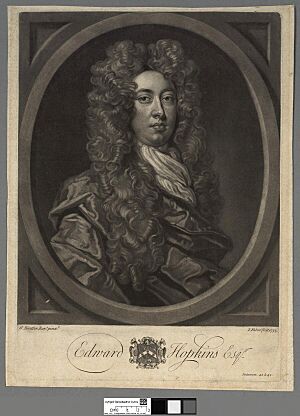Edward Hopkins (MP) facts for kids
Edward Hopkins (born around 1675 – died 17 January 1736) was an important English politician from Coventry. He was a member of Parliament in both England and Great Britain from 1701 to 1727. He also served in the Parliament of Ireland between 1721 and 1727. During his career, he held several government jobs in Ireland.
Contents
Edward Hopkins' Early Life
Edward Hopkins was the son of Richard Hopkins, who was also a Member of Parliament for Coventry. Edward went to Eton College, a famous school, from 1687 to 1692. After that, he studied at Trinity College, Oxford starting in 1692.
Between 1696 and 1700, Edward went on a long trip called a Grand Tour. He traveled through countries like Flanders (which is now part of Belgium), France, and Italy. This kind of trip was common for young gentlemen at the time to learn about European culture and politics.
Edward Hopkins' Political Career
Edward Hopkins started his political journey as a Whig politician. The Whigs were one of the main political groups in England at the time.
Becoming a Member of Parliament
In 1701, Edward was first elected as a Member of Parliament (MP) for Coventry. An MP is someone chosen by voters to represent them in Parliament, which is like a country's main law-making body. However, he lost his seat in the next election in 1702.
He tried again for Coventry in 1705. This election was very chaotic and even turned into a riot! Edward couldn't even attend the voting because he had fallen off his horse. He and his fellow Whig candidate lost that election.
Later Elections and Roles
A new election was held in 1707, and this time Edward Hopkins was elected back into Parliament for Coventry. He was elected again in 1708. In Parliament, he often helped the Whigs by counting votes during important decisions. He voted for a law in 1709 that helped people from Palatine (a region in Germany) become citizens. He also voted to impeach Dr. Sacheverell in 1710, which means he supported putting the doctor on trial for his actions.
In 1710, Edward lost his seat in another tough election. He then moved to represent Eye in 1713. He was helped to get this seat by a powerful person named Lord Cornwallis.
Edward was re-elected without anyone running against him for Eye in 1715. Even though he was elected again in 1722, he spent a lot of time in Ireland.
Working in Ireland
Edward Hopkins took on many important roles in Ireland. From 1716 to 1722, he was an Irish Commissioner of Revenue. This meant he helped manage the money and taxes collected by the government in Ireland.
From 1721 to 1727, he was also an MP in the Parliament of Ireland for Dublin University. From 1721 to 1724, he served as Chief Secretary for Ireland. This was a very important job, working closely with the Duke of Grafton, who was the Lord Lieutenant of Ireland (the King's main representative).
In 1722, Edward was given two more important positions for life. He became the Master of the Revels for Ireland, which meant he was in charge of entertainment and ceremonies. He also became a Privy Counsellor for Ireland, which is a group of trusted advisors to the King. Edward Hopkins did not run for Parliament in the 1727 election.
Edward Hopkins' Later Life and Family
On 1 March 1725, Edward Hopkins married Anna Maria Chamberlayne. She was the daughter of Dr. Hugh Chamberlayne.
Edward Hopkins passed away on 17 January 1736, in Ewell, Surrey. He was buried at St Michael's church in Coventry. His parents, wife, and eldest son were also buried there. A monument at the church described him as a person known for his intelligence, good manners, and other pleasant qualities. The church where he was buried, which later became Coventry Cathedral, was sadly destroyed during World War II.
Edward and Anna Maria had three sons and two daughters. Sadly, all their sons died without having children of their own. His eldest son, Richard Hopkins, also became an MP and served for over 30 years. His daughter Anne married William Northey, who was also an MP.


